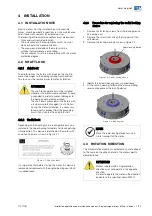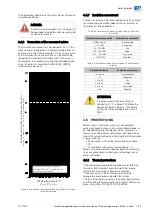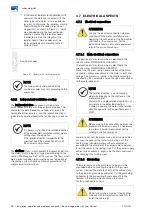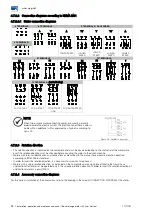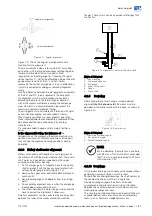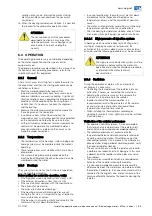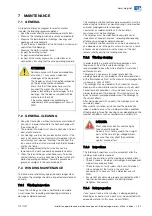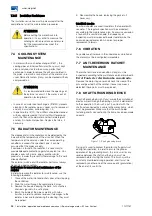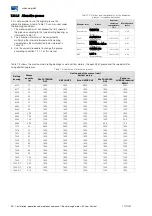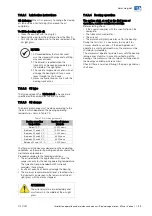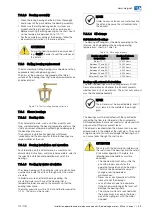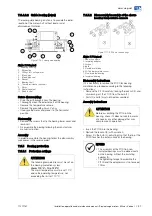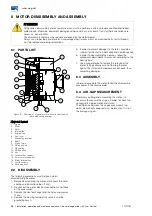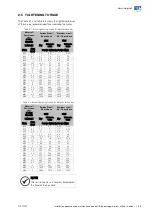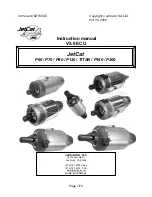
11371757 Installation, operation and maintenance manual – Squirrel cage motor – M line – Vertical
l 35
variation of any value, interrupt the motor starting,
identify possible causes and make the necessary
corrections;
16.
When the bearing temperatures stabilize, it is possible
to proceed to the other motor operation steps.
ATTENTION
The noncompliance with the procedures
described in section 6.2 may impair the
motor performance, cause damages and
even lead to its burnout, voiding the
warranty.
6.3
OPERATION
The operating procedures vary considerably depending
on the motor application and the type of control
equipment used.
The general procedures are described in this manual. For
the control system operating procedures, refer to the
specific manual of this equipment.
6.3.1
General
After a first successful starting test, couple the motor to
the driven load, and then the starting procedure can be
reinitiated, as follows:
Start the motor coupled to the load until its
temperature stabilizes and check for unusual noises,
abnormal vibrations or excessive heating. If significant
vibration variations occur regarding the initial operation
condition until the condition after reaching thermal
stability, then it is necessary to check the alignment
and the leveling.
Measure the current consumption and compare it to
the value given on the nameplate.
In continuous duty, without load variation, the
measured current must not exceed the value indicated
on the nameplate multiplied by the service factor;
All the instruments and devices for measurement and
control must be permanently monitored to detect
occasional alterations, determine their causes and
make the proper corrections.
6.3.2
Temperatures
The temperatures of the bearings, stator winding and
cooling system must be monitored while the motor is
operating.
These temperatures must stabilize within 4 to 8 hours
of operation.
The stator winding temperature depends on the
machine load; therefore, the driven load must also be
monitored during the motor.
6.3.3
Bearings
The system start, as well as the first hours of operation,
must be monitored carefully.
Before putting the motor into operation, verify:
If the high-pressure oil injection system (if any) is ON;
If the external lubrication system (if any) is ON;
If the used lubricant complies with the specifications;
The lubricant characteristics;
The oil level (oil-lubricated bearings);
If the bearing alarm and trip temperatures are set;
During the first start, it is important to pay attention to
unusual vibrations or noises;
If the bearing is not working silently and smoothly, the
motor must be shut down immediately;
In case of overheating, the motor must be shut down
immediately for the inspection of bearings and
temperature sensors, and the correction of possible
causes;
The motor must operate for several hours until bearing
temperatures stabilize within the specified limits;
After the bearing temperatures stabilize, check if there
are no leaks through the plugs, gaskets or shaft end.
6.3.3.1
High-pressure oil injection system
In bearings which have the option for shaft lifting when
starting or stopping by means of oil pressure, the
activation of this system is done by means of an external
oil pump, and the following procedure must be observed:
ATTENTION
The high-pressure oil injection system must be
switched on before putting the motor into
operation and during the shutdown procedure,
as informed in the motor technical
documentation.
6.3.4
Radiators
During the operation of motors with air-water heat
exchanger, it is necessary:
Controlling the temperature at the radiator inlet and
outlet and, if necessary, correcting the water flow;
Adjusting the water pressure just to overcome the
resistance in the pipes and in the radiator;
In order to control the motor operation, it is
recommended to install thermometers at the radiator
air and water inlets and outlets and record these
temperatures at certain time intervals;
When installing the thermometers, recording or
signaling instruments (siren, lights) can also be installed
in certain places.
Verification of the radiator performance
For operation control purposes, it is recommended
that water and air temperatures at the radiator inlets
and outlets be measured and recorded periodically;
The radiator performance is expressed by the
temperature difference between cold water and cold
air during normal operation. This difference must be
checked periodically. If an increase in this difference is
observed after a long period of normal operation, verify
the need for radiator cleaning.
The accumulation of air inside the radiator can lead to
a performance reduction or to its damage. In this case,
a deaeration of the radiator and the pipes may solve
the problem;
The water pressure differential can be considered an
indicator of the need for cleaning the radiator.
It is also recommended to measure and record the
difference between the water pressure before and after
the radiator. Periodically, the values measured must be
compared to the original value, and an increase of the
pressure differential indicates the need for cleaning the
radiator.
Содержание M line Series
Страница 2: ......
Страница 4: ......
Страница 6: ......
Страница 58: ...www weg net 58 l Installation operation and maintenance manual Squirrel cage motor M line Vertical 11371757...

